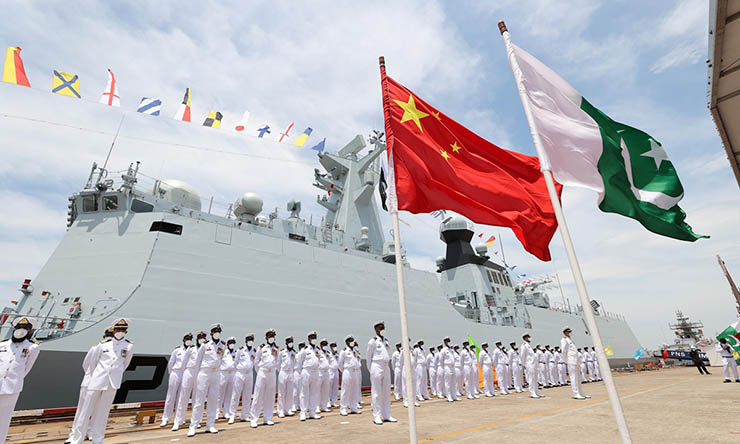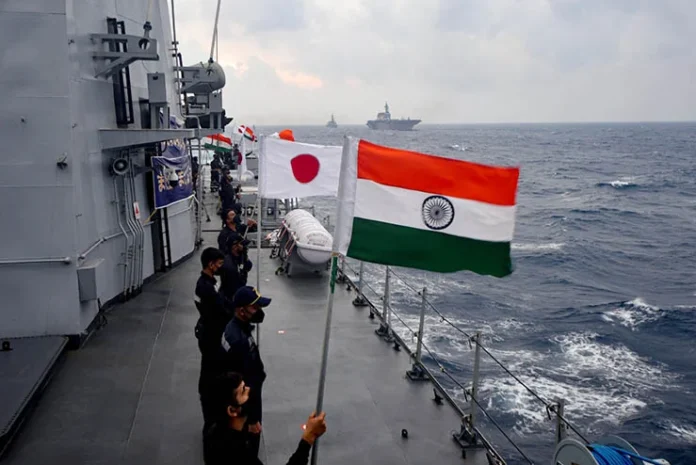From 1991 to 2020, the Indian Navy underwent a remarkable transformation, evolving from a force focused on protecting India’s immediate periphery to one capable of projecting power in the Indo-Pacific. The driving force behind this modernisation has been the strategic rivalry between China and India, as the Chinese navy expanded its presence in the Indian Ocean.
India’s new Maritime Doctrine lays out that the Navy’s strategic vision will no longer be limited to the northern Indian Ocean, but will extend to distant trouble spots. Indian Navy flotillas are now a familiar sight in the South China Sea where they conduct patrols to dent China’s claim that it is a Chinese lake.
As Chinese naval visits to the Indian Ocean Region grew, New Delhi faced escalating points of rivalry with China, prompting a reevaluation of its naval capabilities. These critical junctures further heightened threat perceptions in India, influencing its naval modernisation efforts. While India’s rising economy – which brings with it the imperative to protect the vast sea trade – is a contributor to India’s naval modernisation, the primary driver remains the Sino-Indian strategic rivalry.
China’s Expanding Presence
For nearly six decades after the Chinese Communist Party came to power in 1949, the Chinese People’s Liberation Army (PLA) had a focus on land power. However, China’s Military Strategy released a report in May 2015, emphasising maritime operations for the first time. “It is necessary for China to develop a modern maritime military force structure commensurate with its national security and development interests, safeguard its national sovereignty and maritime rights and interests, protect the security of strategic sea lines of communication and overseas interests, and participate in international maritime cooperation, so as to provide strategic support for building itself into a maritime power,” the report said.
In 2023, the US Department of Defense published the China Military Power Report, which reveals that China is succeeding in its efforts to strengthen its capabilities to reach farther into the Pacific Ocean and beyond
In 2023, the US Department of Defense published the China Military Power Report, which reveals that China is succeeding in its efforts to strengthen its capabilities to reach farther into the Pacific Ocean and beyond. The report says:
*In 2022, China turned to the PLA Navy as an increasingly capable instrument of statecraft, adopting more coercive actions in the Indo-Pacific region against the United States and US allies and partners.
*PLA Navy’s coercive and risky operational activities targeting foreign aircraft and maritime vessels throughout 2022 included: lasing; reckless manoeuvres; close approaches in the air or at sea; high rates of closure; discharging chaff or flares in close proximity to aircraft; and ballistic missile overflights of Taiwan.
India hits back
In November 2023, the Indian military brass uncharacteristically rebuked China for its aggressive behaviour in the South China Sea. The Chief of the Naval Staff, Admiral Hari Kumar, expressed concern over instances of bullying by the Chinese militia or navy, emphasising the threat to the good order and discipline at sea. “The fragile security situation in the South China Sea, where the growing number of instances of bullying of smaller navies, including fishermen, by the Chinese militia or its navy, poses a clear and present danger to the good order and discipline at sea,” the Admiral said.
“Owing to the increased presence of multinational forces and differing interpretations of international laws, there is this fear that the region’s global commons can change to contested seas,” he said.
Taking on China
The Navy chief’s rare and direct criticism reflects India’s growing concerns over China’s actions in the region. While China’s maritime moves are primarily in step with its great-power competition with the United States, Beijing’s growing military capabilities at sea directly impact India. By 2027, China is expected to station at least one aircraft carrier group permanently in the Indian Ocean Region, posing a challenge to India’s position as a central player. Under initiatives like the Belt and Road Initiative and String of Pearls strategy, China’s focus on India’s coastal neighbours has raised concerns in New Delhi. Against this backdrop, the Indian Navy has decided to take on its much larger rival through the following steps.
“The fragile security situation in the South China Sea, where the growing number of instances of bullying of smaller navies, including fishermen, by the Chinese militia or its navy, poses a clear and present danger to the good order and discipline at sea,” says India’s Chief of the Naval Staff Admiral Hari Kumar
Naval Fleet Expansion
In order to enhance its maritime capabilities, India has launched an ambitious naval expansion programme through the induction of advanced platforms, including submarines, destroyers, frigates and aircraft carriers. The Navy has announced plans to expand the fleet to 170-175 ships by 2035. Currently, 67 ships are under construction, with 65 being built in Indian shipyards. In comparison, the PLA Navy operated over 370 ships and submarines, with plans to further increase its fleet to 435 by 2030. China’s rapid expansion highlights the urgency for India to bolster its naval capabilities.

The Maritime Doctrine of 2015 lays out that the Indian Navy’s strategic vision will no longer be limited to the northern Indian Ocean, but will extend to the southeast Indian Ocean, the Red Sea, the western coast of Africa and the Mediterranean Sea. Such a doctrine cannot be implemented without carrier battle groups that will provide the capability to sail out to distant troubled spots. Having acquired its first aircraft carrier in the 1950s, the Navy is no rookie when it comes to strategy and tactics. In operational terms, India achieved spectacular success with aircraft carriers in the 1971 War. Deck aviation assets have also helped India to quickly respond to the Indian Ocean tsunami in 2004 and provide humanitarian assistance and disaster relief to countries in Southeast Asia.
India’s commitment to developing and operating aircraft carriers, such as INS Vikramaditya and the upcoming INS Vikrant, signifies its intention to project power and secure maritime interests in distant waters.
Strategic Partnerships and Alliances
India is an active member of the Quadrilateral Security Dialogue (Quad) alongside the United States, Japan and Australia. The Quad fosters collaboration on security and maritime issues, countering China’s influence in the Indo-Pacific. As part of their deployment, Indian ships take part in annual joint war drills involving the United States, Japan and Australia, enhancing interoperability and signalling a commitment to a rules-based international order.
Counterbalancing China’s String of Pearls Strategy
India views the protection of sea lanes as crucial to its economic interests. The Navy works to ensure the safety and security of vital maritime routes against potential threats, countering China’s efforts to establish a “String of Pearls” in the Indian Ocean Region. The Indian Navy conducts freedom of navigation operations in the South China Sea, challenging China’s territorial claims and asserting the principle of free navigation in international waters.
India has launched an ambitious naval expansion programme through the induction of advanced platforms, including submarines, destroyers, frigates and aircraft carriers. The Indian Navy has announced plans to expand the fleet to 170-175 ships by 2035
The Indian Navy’s activity in the region included the August 2021 deployment of four ships, including a guided-missile destroyer and a missile frigate, to Southeast Asia. “The deployment of the Indian Navy ships seeks to underscore the operational reach, peaceful presence and solidarity with friendly countries towards ensuring good order in the maritime domain,” India said in 2021.
According to a paper published in the Foreign Policy Research Institute by Harsh V Pant, India’s “Look East” policy, originally aimed at strengthening economic ties with its Southeast Asian neighbourhood, has now led to naval exercises with Singapore, Thailand and Indonesia. The member states of the Association of South-East Asian Nations (ASEAN) have joined the Indian Navy in policing the Indian Ocean Region to check piracy, trafficking and other threats to sea lanes. “To more effectively counter Chinese presence in the Indian Ocean and to protect its trade routes, India will have to seek access to the Vietnamese, Taiwanese and Japanese ports for the forward deployment of its naval assets. India is already emerging as an exclusive defence service provider for smaller states with growing economies that seek to strengthen their military capabilities in Southeast Asia and West Asia.”
As well as holding military exercises with practically every country in the Indo-Pacific, India is offering advanced weaponry to these countries. Under a January 2022 deal, New Delhi will provide the Philippines with its indigenously developed BRAHMOS anti-ship supersonic cruise missiles. These missiles will provide the Philippine Navy with counterattack capabilities in the South China Sea.
Ramping up the Pressure
China’s vast economy – which is at least four times larger than India’s GDP – has allowed the PLA Navy to go on a spending spree, acquiring large numbers of warships, submarines and anti-ship missiles. Since New Delhi cannot match the dragon dollar for dollar, it needs to prioritise and use force multipliers. This policy can include the following steps:
- Extended Deployment: The Indian Navy has increased its operational presence in the Indo-Pacific, especially in the South China Sea, demonstrating its commitment to regional stability. Deployments to areas like the South China Sea signal India’s intent to safeguard its interests beyond its shores. However, these deployments were of a limited scope and duration. The Navy must acquire the capability to deploy warships for extended periods off China. For credible force posturing, it will have to deploy a battle group centred around a nuclear-powered aircraft carrier. The Chinese already have a nuclear powered carrier on the drawing board. Given the speed with which China is able to manufacture large weapons platforms, the Type 004 aircraft carrier may be launched by the late 2020s, with a total of four carriers planned. The Type 004 will be larger than the current two PLA Navy carriers and may be mounted with laser weapons and railguns.
The Indian Navy’s assertive stance against the PLA Navy reflects the evolving geopolitical dynamics in the Indo-Pacific region. Faced with China’s expanding maritime influence, India strategically enhances its naval capabilities to safeguard its interests, counter Chinese assertiveness, and maintain stability in the Indian Ocean
- Strengthen China’s neighbours: India must provide nuclear weapons to Vietnam. A nuclearised Vietnam in China’s underbelly will force China to divert resources to that sector. Anti-proliferation groups worldwide will no doubt be outraged by the move, but it will rattle the communist dictatorship in Beijing. Any Chinese protests will be meaningless – and hypocritical – because the Pakistani nuclear weapons programme was entirely backed, funded and tested by China.
- Choke China: The Malacca Strait, a narrow waterway between the Malay Peninsula and the Indonesian island of Sumatra, is one of the world’s busiest sea lanes through which China imports nearly all of its oil. Much of Chinese exports also pass through this chokepoint. Just 2.7 km at its narrowest point, it is one of the easiest sea lanes to block. India must apply pressure on this bottleneck by building up its naval base at Andaman & Nicobar Islands. The islands are home to the A&N Command, the country’s only tri-service theatre command. Using this base, the Navy must deploy warships near the Malacca Strait to signal to the Chinese that if they get too adventurous off India’s coasts, India has the ability to choke China’s sea trade.
Endgame
The Indian Navy’s assertive stance against the PLA Navy reflects the evolving geopolitical dynamics in the Indo-Pacific region. Faced with China’s expanding maritime influence, India strategically enhances its naval capabilities to safeguard its interests, counter Chinese assertiveness, and maintain stability in the Indian Ocean. The Navy’s proactive engagements, partnerships and modernisation efforts are critical elements in navigating the complex challenges posed by China’s growing presence in the maritime domain.
– The writer is a globally cited defence analyst. His work has been published by leading think tanks, and quoted extensively in books on diplomacy, counter terrorism, warfare and economic development. The views expressed are of the writer and do not necessarily reflect the views of Raksha Anirveda
–The writer is a globally cited defence analyst based in New Zealand. The views expressed are of the writer and do not necessarily reflect the views of Raksha Anirveda






